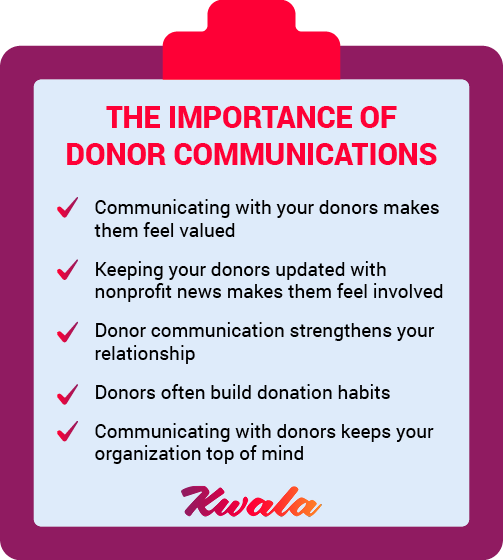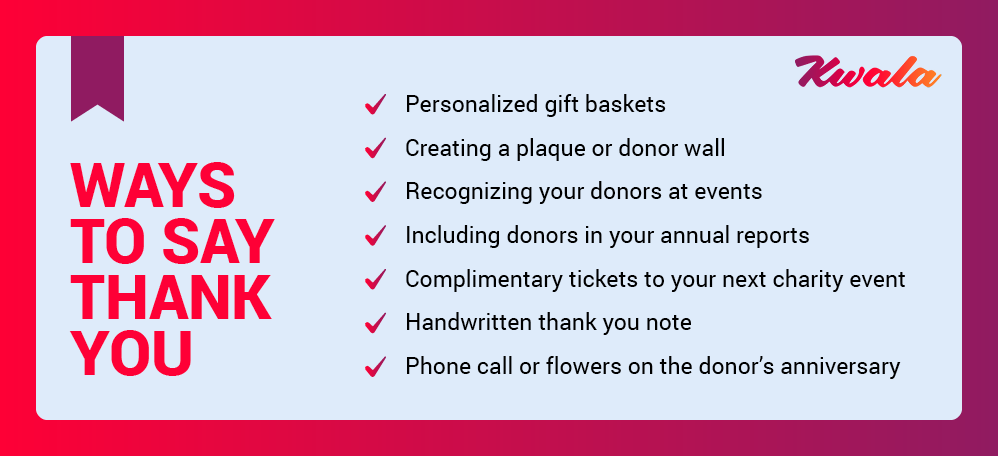
Any nonprofit professional will tell you their organization’s success relies on a broad community of committed individuals. A critical aspect of this network is, of course, nonprofit donors. However, with so many responsibilities to manage, how do you strengthen your connection with current donors while expanding your donor network?
According to a recent survey, 20% of potential donors do not give simply because they are not asked. If your organization wants to increase donations and donor retention, building a communication strategy is the best place to start.
In this guide, we will review some simple ways to keep your donor communication thoughtful and effective. Here’s what we’ll cover:
- Why are donor communications important?
- How do you build a relationship with donors?
- Top 6 Donor communication tactics
Donor communications are a wise investment of your time because they reap several practical benefits. If you keep in touch with your current donors, they will be appreciative and more eager to get involved. If you reach out to potential donors, you can build a solid foundation for a lasting relationship.

Here are some additional reasons why your communication efforts matter:
- Communicating with your donors makes them feel valued. Ideally, each donor should feel valued and appreciated for their contributions. Your communication indicates that you are thankful for their gifts.
- Keeping donors updated with your nonprofit news makes them feel involved. Sharing relevant updates is another way to keep your donors informed. In fact, 61% of donors claim that they choose which nonprofits to give to based on how they use their money. Let your donors know how their offering is making a difference.
- Donor communication strengthens your relationship. The more you talk to your donors, the better they will get to know you and vice versa. Interact with your followers online to foster more connections. When you invest time in your relationship with them, they will become a champion for your mission.
- Donors often build donation habits. Did you know that up to 60% of donors are more likely to become recurring donors after their second gift? This means you have a window after a donor’s first gift to maximize your communications efforts. Take this opportunity to thank them and welcome them to your organization’s team.
- Communicating with donors keeps your organization top of mind. Word of mouth is one of the best ways to advertise your nonprofit. If you thoughtfully communicate with your donors, they are more likely to mention your mission and encourage others to participate.
Perhaps you already knew the importance of donor communication, but are just not sure how to get started. If this is the case for you, check out the section below which covers donor relationship tips.
How do you build a relationship with donors?
One way to conceptualize donor communication is by comparing it to your successful personal relationships. Hopefully, these relationships are balanced and mutually beneficial.
If your closest friend only reached out when they needed something, that relationship would quickly become burdensome. In the same way, when connecting with donors, be sure that your communication consists of more than just monetary requests.
To avoid this pitfall, let’s explore how to construct and maintain a meaningful, symbiotic donor relationship.
Create a communications strategy
Picturing your donor communication as a process rather than as a one-time request can be incredibly helpful. Consider implementing a variety of communication types when reaching out. Follow-up letters, seasonal check-ins, and fundraising opportunities are all communications you can leverage.
Creating a donor communication calendar is a great way to ensure you are keeping in touch on a regular basis. This calendar can include specific fundraising events as well as important fundraising seasons to keep your donors informed.
For instance, you can plan reminders prior to and thank you messages following Giving Tuesday. Or maybe your nonprofit heavily emphasizes end-of-year giving. Planning holiday-themed communication efforts will help you galvanize support.
Your audience will differ depending on your nonprofit type. Research and experiment with which communication channels are best suited to reach your donors. For instance, a text message may not be an effective option for a donor who is used to receiving regular email newsletters.
Top nonprofit communication channels
What channels does your nonprofit currently use to get in touch with donors? Expanding the platforms you use for communication can help attract new donors and encourage your current ones to engage with you in new ways. For example, a donor you regularly email may discover and decide they want to join your social media campaign.
A few channels to consider and strategies for leveraging them include:
- Email. Email is one of the most useful direct marketing tools, allowing you to quickly send personalized messages to all of your supporters. Set up automatic emails for specific interactions, such as a supporter donating or signing up for an event, so they are immediately thanked or pointed toward helpful follow-up information.
- Text message. If you have a short, urgent message for supporters, text messages are the way to go. For example, a nonprofit running an advocacy campaign might text supporters on a specific day to encourage them to contact their representatives, or you might let donors know when there are just a few hours left to donate on Giving Tuesday to help you reach your goal.
- Social media. Social media provides your nonprofit with access to a massive audience. However, not every platform is equally effective for nonprofit marketing. For example, studies show that marketing on Google has an average conversion rate of 8%, whereas Twitter has 0.9% and YouTube just 0.5%. These platforms still have their uses for spreading your content but may not lead to donations as frequently as other channels.
- Direct mail. With increases in digital marketing, direct mail hasn’t fallen by the wayside. Instead, a physical thank you card or letter can feel much more meaningful and give supporters the impression that your nonprofit is really going out of its way to build a connection.
- Phone calls. Personally calling a donor is one of the most direct ways to establish a personal relationship with them, and studies show that nonprofits that call donors to thank them within 48 hours of receiving a gift are four times more likely to earn a second donation. When it comes to phone calls, be quick to make your call after an important interaction, have a script ready, and take notes about the donor that can be helpful for future interactions.
Pay attention to supporter preferences when it comes to communication channels, so you can get in touch in whatever way works best for them. If supporters are open to being contacted on multiple channels, you can even try taking an omni-channel approach to donor communications, which we’ll discuss later.
Include relevant information
Donors have busy lives. Make sure your communications only include relevant, necessary information.
How do you decide which details to include? This answer will depend on the type of communication you are sending, but in general, here are the top two must-haves:
- How your nonprofit is using its donations. Your nonprofit could use donors’ gifts to fund your volunteer programs or purchase supplies for your community center. However your donor’s dollar is being used, it’s important to keep them informed. When you do this, it communicates to donors that your organization carefully and responsibly manages donations.
- The specific benefits of your funded work. This could look like sharing beneficiary testimonies or practical, outlined goals. For instance, if your nonprofit works with local food banks, you could include how many meals you served last year as well as how many you are on schedule to serve this year. Including these benefits helps your donor grasp the tangible good their gift gives.
When you answer these two questions, donors understand how their money is used and will feel more confident when donating in the future.
Emotionally connect
Just including objective facts about your organization isn’t as compelling as emotionally sharing your nonprofit’s purpose. Sharing facts about your goals and upcoming events is great, but don’t forget to emphasize why you’re doing what you’re doing.
Donors tend to donate to a variety of causes, so sharing what makes your mission unique is an effective way to get their attention. After all, donors likely give to your organization because they believe in your values. Remind them that their gifts are for a greater good.

Cultivate a team spirit
Your donors are a part of your nonprofit team. When choosing words and phrases, be sure to keep them engaging rather than strictly objective. Using “we” and “you” instead of “I” reinforces that your donors are an integral part of your organization.
Let’s face it—no one enjoys being talked at. When drafting donor communications, be sure to convey a friendly tone.
Emphasize your story in action
Just including objective facts about your organization isn’t as compelling as emotionally sharing your nonprofit’s purpose. Sharing facts about your goals and upcoming events is great, but don’t forget to emphasize why you’re doing what you’re doing.
Donors tend to donate to a variety of causes, so sharing what makes your mission unique is an effective way to get their attention. After all, donors likely give to your organization because they believe in your values. Remind them that their gifts are for a greater good.
When telling a story about your organization, make sure to place the donor as the hero. For example, a church might run a text messaging campaign to raise money for food pantry supplies. To emotionally connect with their audience, the organization could explain how donors’ support is needed to feed hungry families, and a donation as little as $10 could help provide warm meals for 10 people. This reiterates the church’s mission to give back to the community and helps supporters understand how their contributions will be used.
Top 6 Donor communications tactics
Sometimes reaching out to donors is easier said than done. You can have the right idea, but struggle to execute it. That’s why we have created a list of practical tips to elevate your strategy. Use these tips to edit, rewrite, or jumpstart your donor communication.
1. Segment your donor lists and adjust your strategies
You wouldn’t speak to your best friend the same way you speak to your boss. The same concept applies to donor communications.
Delve into your donor data and create donor lists based on shared characteristics. By doing this, you can segment your donors and create specific strategies based on those lists.
Different ways to segment donors include by:
- Age
- Donation frequency
- Donation size
- Donation type
- Volunteer status
After organizing your donor data, implement a strategy to target each donor group. This way, you can keep your communications specific. For instance, a new donor may receive more information about your nonprofit while a long-time donor could receive a thank you for their 10 years of faithful giving.
Additionally, different age groups prefer different communication types. If you’re not sure what the best way to reach a donor is, just ask them. Provide them with a choice to receive emails, direct mail, phone calls, or text messages.
When you tailor your communications, you indicate to each donor that their individual contribution matters, regardless of its size or frequency.
2. Simplify your content
Fancy word usage and jargon are turn-offs for most potential donors. This is not because your donors are dull, but because they have full schedules.
When you add too much fluff to your messaging, it forces your donors to use extra brain power to untangle your point. To keep your wording simple, aim for a sixth-grade reading level.
Tatango’s guide to nonprofit text messaging also recommends sticking to a single call to action per communication. For example, you might direct supporters to give to your fundraising campaign, sign up to volunteer, or register for your upcoming event—but not all of these at once. Incorporating too many next steps can overcomplicate your message and overwhelm supporters, so boil down your communication to the most important action your recipients should take.
Another readability aspect to consider is including non-English messaging. If your donors are bilingual or have a different first language, make it easier for them to understand you.
Additionally, you should double-check that your communication is legible in all formats. Tiny fonts and cut-off sentences cause your readers to strain their eyes or abandon your messaging altogether. To avoid this, optimize your messages for all communication types: print, desktop, mobile, and tablet.
3. Focus on the bigger goal
What makes you passionate about your organization? How does your nonprofit contribute to a better tomorrow? Including your nonprofit’s future goals and hopes offers donors an optimistic perspective.
For instance, many community shelters exist with the goal to end homelessness for good. Pictured this way, each shelter and donation is one step closer to fulfilling this overarching intention.
Here are some practical ways to emphasize your bigger goal:
- Include photos of your beneficiaries and staff
- Include photos of your volunteers making a difference
- Capture pictures of your event attendees
- Photograph progress since the establishment of your organization
When you show photos of your team at work, donors begin to understand their donation’s ripple effect. The visual evidence makes them feel like they are a part of something bigger than themselves.
4. Delegate jobs
Several donors want to get more involved in their nonprofits, but just aren’t sure how. Don’t be afraid to invite your donors to participate in hands-on activities! This can show them that your nonprofit values their continued input and trusts them to be ambassadors for your cause. Remind them that though you appreciate their donations, you welcome all types of service.
Other job suggestions to give your donors could be to gather volunteers, raise a certain amount by the end of the year, or complete a matching gifts initiative. When you highlight your needs upfront, you let donors choose which project is best for them to give to.
5. Prioritize gratitude
The final and perhaps most important communication tactic is to prioritize gratitude. The more individualized and specific you are in expressing your gratitude, the better. Sending personalized thank you letters with the donor’s name and how their contribution benefited the community is one example.
Consider giving personalized donor gifts to make your donors feel appreciated for their individual contributions. These gifts do not have to be expensive, just make sure they are thoughtful and timely.

Other ways to foster a spirit of gratitude include:
- Sending personalized gift baskets
- Creating a plaque or donor wall to commemorate your donors
- Recognizing your donors at events
- Including donors in your annual reports
- Giving them complimentary tickets to your next charity event
- Writing a handwritten thank you note
- Giving them a phone call or sending them flowers on the donor’s giving anniversary
Keep in mind that gratitude is incredibly contagious. Cultivating a habit of thanking your staff members and volunteers can be helpful to set an expectation of gratefulness.
6. Take an omni-channel approach
Omni-channel marketing is a style of communication where you contact supporters through multiple platforms. However, it differs from multi-channel marketing in that with multi-channel, you spread the same message across multiple platforms, whereas in omni-channel, each message builds on the one that came before it.
For example, your nonprofit might try expanding its organic traffic by using the Google Ad Grant and hosting campaigns with keywords related to their local area. A supporter clicks on one of these ads and subscribes to your newsletter.
The supporter gets a welcome email that thanks them for subscribing and encourages them to check out upcoming in-person events to learn more about your organization. In the next few days, they receive a letter in the mail inviting them to a specific event. After attending the event, they receive a text thanking them for attending the event and asking whether they would consider donating to help the campaign the event promoted.
This approach encourages supporters to keep moving forward in their donor journey, while keeping their attention by changing communication methods. To facilitate an omni-channel approach, make sure your branding is consistent across all communication channels so it’s clear each message is coming from you. This helps boost brand awareness and reassures supporters they’re connecting with your nonprofit.

Final Thoughts + Additional Resources
Building your donor network takes time, but if you follow these best practices you will forge lasting relationships. Everyone likes to feel appreciated for their contributions, so be actively on the lookout for opportunities to say thank you.
As you build out your communications strategy, make sure you have the right tools on hand. Your communications toolkit should include:
- Text fundraising platform
- Email marketing platform
- Social media schedulers
- Constituent relationship management (CRM) software
Do your research to find nonprofit-specific solutions that can meet your needs and help ease your administrative burden.
Eager to learn more? Check out some of our other favorite nonprofit resources to help improve donor communications:
- Nonprofit Newsletter Template for Nonprofit Marketers. Simplify your newsletter organization with this easy guide!
- Graphic Design for Nonprofits: What to Know & 9 Free Tools. Learn graphic about helpful nonprofit design tools and shortcuts with this resource.
- The Ultimate Nonprofit Board Report Template and Tips. Ever wonder how you can improve your board report? Here are some simple tips and tricks for you to try out.



